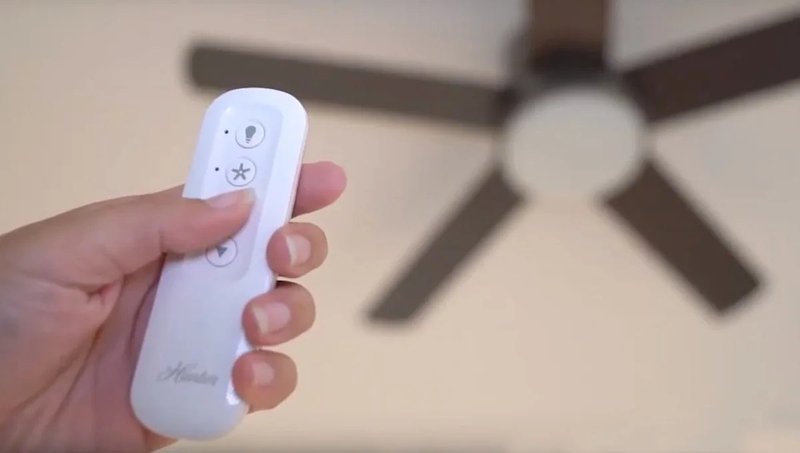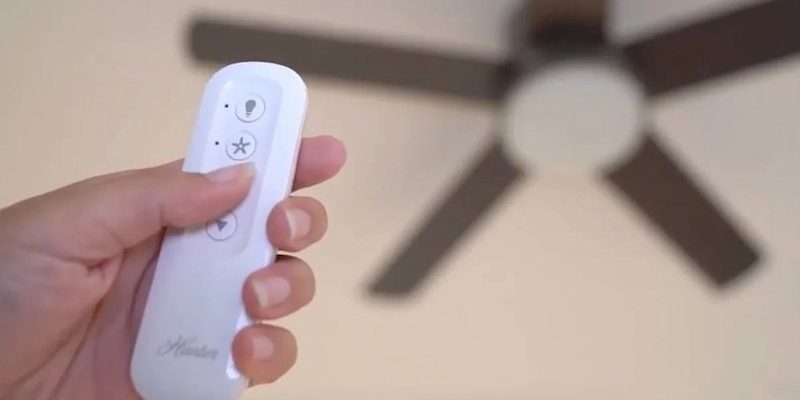
Hunter is known for making sturdy, reliable ceiling fans, and their remotes are meant to be user-friendly. But every now and then, even the best gadgets get cranky. This blinking remote situation can be confusing, especially when you’re simply trying to enjoy a nice breeze or adjust the light. Let me explain what’s actually going on, what your remote wants from you, and how you can stop the endless blinking—without calling in a tech-savvy neighbor, unless that’s your thing.
What Does the Blinking Light on My Hunter Remote Actually Mean?
Here’s the thing: a blinking light on a Hunter ceiling fan remote is its way of signaling something isn’t quite right. It’s almost like the “check engine” light for your ceiling fan system. At first glance, a blinking remote can look like a fatal error, but most of the time it’s pointing to a fixable problem.
Most Hunter remote controls have a small LED that flashes when you press buttons. If this light blinks every time you issue a command, but the fan or lights aren’t responding, you’re getting a warning. Sometimes, that flashing starts happening on its own—no button press needed. It’s your remote’s way of trying to get your attention, and honestly, ceiling fan remotes are not known for their subtlety.
The meaning behind a blinking remote can change a bit depending on the model. For popular Hunter remotes, persistent blinking often means there’s a syncing issue, a pairing problem, or low battery power. If your remote uses a “learning code” system, it may be searching for the fan receiver and not finding it. In rare cases, the blinking might mean there’s interference or a wiring hiccup in the ceiling unit.
Common Causes: Why Does My Hunter Ceiling Fan Remote Keep Blinking?
So why won’t this little light chill out? Let’s break down the top reasons:
- Low batteries. Yep, it’s almost always the simplest fix. Remotes are weirdly dramatic about dwindling power, and blinking is their go-to SOS.
- Lost signal or sync between the remote and fan unit. If you’ve had a power outage, replaced the batteries, or messed with the fan, the remote might have “lost its memory.”
- Pairing/code issues. If your system uses dip switch codes or has a pairing process, any mismatch can cause the remote to go on strike—with plenty of blinking as protest.
- Interference from other electronics or even neighboring fans using the same code.
Think of the remote like a walkie-talkie. If they’re not tuned to the same frequency, all you get is static—or in this case, endless blinking. You might notice that after battery changes, electrical work, or moving furniture, your remote suddenly acts up.
How to Fix a Continuously Blinking Hunter Ceiling Fan Remote
One of the most common questions is, “How do I get the blinking to stop?” The good news: you can troubleshoot most blinking remotes in about ten minutes, no engineering degree required.
Step 1: Replace the Batteries
I know, I know, this sounds obvious. But old or dying batteries (even if your remote still lights up) are the number one culprit. Swap them for a fresh set—preferably name brand, since off-brand batteries sometimes don’t fit just right or provide even power.
Step 2: Re-Sync or Pair the Remote
If your Hunter remote and fan aren’t talking, you’ll need to help them reconnect. Here’s how:
- Turn off power to the fan at the breaker (yes, the actual panel in your basement or garage—safety first!).
- Wait about 10 seconds, then turn the power back on.
- Within 30 seconds, hold down the “pair” or “learn” button on the remote (some models use a combination, like holding “Fan” and “Light” together).
- Wait for the fan to respond—a quick spin or light flash means success!
*If there’s no response, check your user manual for specific code or sync instructions. Some Hunter models use small dip switches (tiny toggles inside the remote and fan receiver) instead of a digital pairing button.*
Step 3: Check for Interference and Code Conflicts
You’d be surprised how often a neighbor’s remote can cross signals, especially in apartments or old houses where fans share similar frequencies. If two Hunter fans are on the same code, they’ll try to “talk” over each other. If you just installed a new fan or your neighbor did, this could be the culprit.
Change the code on both the remote and receiver if you suspect interference. For dip switches, carefully flip them to a unique pattern (record it for next time), then re-pair the devices.
When Should You Reset Your Hunter Remote?
Sometimes, you’ve swapped batteries and re-synced, but the remote is still blinking like it has something to say. At this point, a reset is in order. Think of this as a fresh start for both the remote and your ceiling fan—like turning it off and on again, but fancier.
To reset, follow this general process (but always check your exact manual):
- Remove the batteries from the remote and leave them out for at least 60 seconds.
- While the batteries are out, cut power to the fan at the breaker for one minute.
- Restore power, reinsert batteries, and then press the “pair” or “learn” button on the remote.
- Look for a confirmation—usually the fan or lights will blink or turn on briefly.
If your remote is one of the newer Hunter “universal” models, the reset process might involve holding multiple buttons at once (often “Fan” and “Light” for five seconds). Check for tiny labels or contact Hunter support if nothing is working.
If you ever feel like you’re getting nowhere—don’t forget, sometimes remotes develop hardware issues. In that case, a replacement might be easier than spending hours on troubleshooting.
Hunter Universal Remote vs Brand-Specific Remotes: Does It Matter?
You might be wondering, “Does it matter if I’m using a universal remote or the original Hunter remote for my ceiling fan?” Here’s where things get interesting.
Hunter’s original remotes are programmed to match their specific fan receivers, so pairing and codes tend to work smoothly. Universal remotes, on the other hand, are designed to work with a range of brands and models—sort of like the Swiss Army knives of remotes. They’re convenient, especially if you’ve lost your original or have multiple fans. But, they’re also more prone to blinking issues if they lose sync or if the codes don’t match perfectly.
If you’ve recently switched to a universal remote and suddenly see constant blinking, chances are there’s a code or pairing mismatch. Double-check the settings, and, if needed, go through the pairing process from scratch. If you have the original Hunter remote, stick with it whenever possible for the smoothest experience.
Remote Blinking vs. Fan Receiver Problems
Sometimes, the blink isn’t the remote’s fault at all. The real troublemaker might be the fan’s receiver—the part hidden in the ceiling canopy that gets the remote’s signals. Think of the receiver like the Wi-Fi router for your fan. If it’s not working properly, your remote is basically shouting into the void.
Signs the receiver is the problem:
- Your remote keeps blinking but nothing—the lights, the fan, anything—responds at all.
- You’ve replaced batteries, reset, and re-paired but still get no luck.
- Faint electrical smells, clicking sounds, or inconsistent fan operation after storms or power surges.
If you suspect the receiver, the best step is to turn off power at the breaker and check for any loose wires or visible damage. Replacing a receiver is a DIY-friendly job on some models, but always be careful around electrical connections. When in doubt, call a licensed electrician.
Battery Types and Replacement Tips for Hunter Remotes
Let’s talk batteries. Not all remotes use the same type, and using the wrong one is like putting regular gas in a diesel engine—it’s just not going to work.
Most Hunter ceiling fan remotes use either AAA, AA, or a coin-cell battery (CR2032, for example). Always check the manual or pop open the battery cover to confirm. Here’s a tip: write the battery type on the back of your remote with a marker so you (or the next person) don’t have to guess.
When replacing, make sure to:
- Insert batteries the right way (polarity matters—those plus and minus signs aren’t decorative).
- Use high-quality, non-rechargeable batteries for the longest life and most stable performance.
- Clean the battery contacts gently with a cotton swab if you see any corrosion.
A blinking remote is often just saying, “Feed me!” Low voltage can make the LED blink even if all other functions appear to work.
When to Call for Help or Replace Your Hunter Remote
After you’ve tried new batteries, reset, and paired everything and your Hunter ceiling fan remote is still blinking, it might be time to wave the white flag. Remotes can wear out—buttons stop working, circuits fail, or something inside just gets knocked loose over time.
You can contact Hunter customer support with your model number for advice or order a replacement remote online. Here’s a rule of thumb: If your remote is more than five years old, a new one can save you hours of frustration. And if you’re not comfortable dealing with wiring or electronics, there’s no shame in calling a pro for help.
Sometimes, the stress of a blinking remote just isn’t worth it—especially when summer heat or a dark room is on the line.
Wrapping Up: Stopping the Blink and Regaining Control
Persistent blinking on your Hunter ceiling fan remote can feel like your home is sending you an SOS. The good news? Most of the time, it’s fixable—fresh batteries, a quick resync, or a reset usually do the trick. Sometimes, it takes a little patience and a sense of humor to outsmart your fan’s mysterious signals.
If you’ve tried all the usual tricks and still see nonstop blinking, don’t stress. Hardware wears out, and replacements are straightforward. And let’s be honest, there are worse problems than a stubborn remote. At least now, you know what your Hunter remote is trying to say—and how to get your ceiling fan (and your sanity) back in sync.
